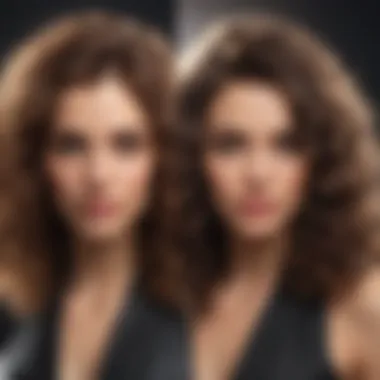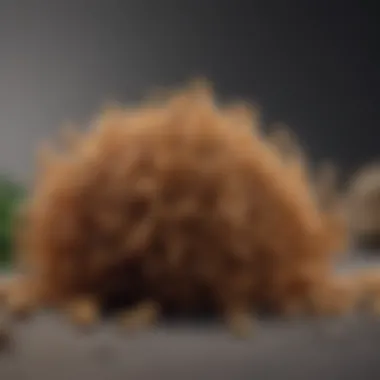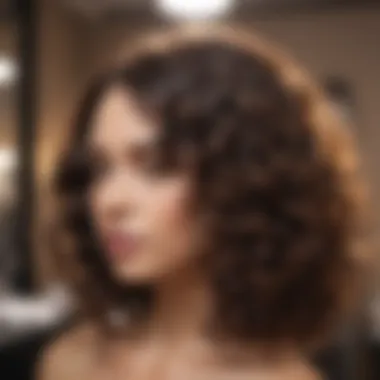Effective Strategies for Reducing Curls


Intro
Curls can be a source of both beauty and frustration. For many, the bouncy, voluminous spirals tell a story of individuality. Yet, for others, the quest for smoother, straighter hair is a persistent aspiration. This article delves deep into effective strategies for managing curls. Whether you're prepping for a big event or just looking for day-to-day ease, understanding the approaches available can make a world of difference.
Curls come with their own unique set of challenges. Excess frizz, tangling, and styling difficulties can hinder one’s self-confidence and daily grooming routines. The good news is, there are numerous options out there to navigate these hurdles. From professional treatments that can yield spectacular results to everyday at-home remedies, we'll explore a diverse range of solutions tailored to fit different needs.
By examining methods like smoothing treatments and curly hair care routines, readers can piece together a well-informed strategy that suits their lifestyle and preferences. So, let's get started on this journey to transforming those curls, exploring options that not only reduce the volume but also aim to maintain the health and integrity of your hair.
Understanding Curls: Hair Texture and Chemistry
Understanding curls is crucial as it lays the foundation for all other strategies discussed in this article. Curls are more than just a hairstyle; they represent an individual's unique hair texture and identity. The chemistry involved in hair structure directly influences the degree of curl and the hair's overall health. Knowing the mechanics behind curls helps one make informed choices about treatment options and care practices.
When we talk about hair texture, we refer to a few specific aspects: the thickness of individual strands, the overall density of hair, and the shape of the hair shaft itself. These elements determine how hair behaves, especially when attempting to reduce curls. Maintaining health is vital in any transformation process, as damaged hair can lead to frizz and breakage, complicating any curl-reduction efforts. In this context, understanding the properties of one's hair can lead to better treatment decisions.
The Science of Hair Structure
Hair is primarily composed of a protein called keratin. This fibrous protein is arranged in a helix, which is fundamentally what gives hair its structure. Each strand is encased in a cuticle, which is a protective layer that can be quite rough.
- Hair Shaft: It refers to the visible part of the hair that extends above the scalp.
- Follicle: The root of the hair resides here beneath the scalp. Follicles play a pivotal role in determining how hair grows and its texture.
The arrangement of these keratin proteins and other structural elements determines whether hair is straight, wavy, or curly. For instance, if the hair shaft is oval, it is more prone to curl, whereas a round shaft type usually results in straighter hair.
Keeping hair healthy is advantageous not just in maintaining its natural texture but also in making any curl reduction approaches more effective. Protecting the cuticle from damage will minimize frizz and enhance the smoothness that many desire from their hair.
Factors Influencing Curl Patterns
The patterns of curls are shaped by several factors. Genetics plays a significant role; your family tree can provide insights into your curl pattern. Yet, it doesn't stop there. Here are some other impactful elements:
- Humidity: High humidity can cause strands to swell, making curls more pronounced.
- Hair Care Routine: The methods and products used can either exacerbate or mitigate the curl.
- Heat Exposure: Whether from styling tools or environmental conditions, heat can temporarily alter curl patterns.
- Chemical Treatments: Relaxers and colors can change curl patterns but must be approached cautiously due to potential hair damage.
As someone seeks to reduce curls, understanding these factors is vital. Addressing humidity levels, deciding on how to care for hair routine, and knowing when to use or avoid heat can lead to significant difference in outcomes. Each element intertwines with the others, creating a complex web that is your unique hair.
"Hair is like a canvas; every stroke of care, treatment, and understanding creates a masterpiece of texture."
Professional Treatments for Curls
In the quest for smoother hair, professional treatments stand as one of the most potent methods for drastically reducing curls. These options are particularly appealing to those who are looking for lasting solutions, rather than temporary fixes that may evaporate with the next shower. Professional treatments can not only transform the hair's texture but also enhance manageability, leading to a more polished and sophisticated appearance. It's vital, however, to approach these treatments with a clear understanding of their benefits and potential pitfalls.
Keratin Treatments
Keratin treatments have gained popularity among women yearning for sleek strands. The process generally involves applying a keratin-rich formula to the hair, which is then sealed in with heat. This method smooths out frizz and aligns the hair cuticles, giving a strikingly shiny finish. Many find that these treatments reduce curliness significantly, often for several months.
However, the longevity of a keratin treatment can be influenced by various factors such as hair type, the specific product used, and aftercare routines. It’s essential to follow up with sulfate-free shampoos to prolong the effects. Overall, many individuals rave about the ease of styling their hair post-treatment, as it tends to require less effort and time.
Chemically Straightening Treatments
Chemically straightening treatments represent a more intense avenue for curl reduction. These methods typically utilize strong chemical solutions to alter the hair's internal bonds, resulting in straighter hair. Although effective, it's crucial to be aware of the potential damage they can inflict. Over time, repeated chemical straightening might lead to brittleness and breakage.
When considering this route, it’s wise to consult with a professional stylist who can assess your hair’s health and recommend the best products. Regular conditioning treatments and moisturizing routines can help to mitigate damage and keep the hair looking vibrant. Furthermore, recognizing your hair’s response to harsh chemicals is critical—what works for one person may not translate well to another.
Japanese Hair Straightening


Japanese hair straightening, also known as thermal reconditioning, is often viewed as the gold standard in hair straightening methods. This technique not only changes the structure of the hair to be permanently straight but also allows for distinctive shine and smoothness. Unlike traditional straightening that relies heavily on chemicals, Japanese straightening combines thermal and chemical processes.
This procedure is highly technical and should only be performed by a trained professional. The results can be nothing short of transformative, often lasting up to a year. However, the commitment can be daunting both in terms of cost and aftercare. Maintaining the streamlined quality requires adhering to certain hair care practices, such as using designated products and avoiding excessive heat styling. If one is seeking a long-lasting solution that delivers noticeable results, this method may be worth considering as part of the broader strategy for curl reduction.
At-Home Techniques to Reduce Curls
When it comes to managing curls, having effective at-home techniques can be a game changer. These methods allow individuals to take control of their hair without frequent salon visits. Not only does this save time and money, but it also provides options tailored to one’s specific hair needs and preferences. Embracing at-home techniques helps to foster a deeper understanding of hair care, making it easier to maintain a smoothly styled appearance.
Heat Styling Methods
Flat Ironing
Flat ironing is often the go-to method for many lookin’ to smooth out their curls. Its primary purpose is to apply heat evenly across the strands, effectively altering the hair's shape temporarily. The key characteristic of a flat iron is its ability to reach high temperatures, allowing users to achieve sleek looks in minutes.
The uniqueness of this method lies in the precision it offers. A high-quality flat iron can glide through the hair seamlessly, preventing excessive friction that can lead to damage. This advantage makes flat ironing a popular choice for quick styling.
However, it comes with a disclaimer—overusing heat can lead to long-term damage, frizz, and breakage. It’s important to use a heat protectant spray and limit the frequency to keep hair healthy.
Blow Drying Techniques
Blow drying can be another useful strategy for reducing curls. By directing heated air at the roots and lengths of hair, a blow dryer helps in setting the hair into a straighter appearance. The key characteristic here is airflow, which aids in achieving volume while smoothing out curls.
A unique feature of blow drying is its styling versatility. Adjustable heat settings allow individuals to choose what's best for their hair type. With the right brushes, the results can range from straight and sleek to a smooth, wavy texture.
That said, caution is necessary. Just like with flat ironing, excessive heat can lead to dryness and damage. Holding the dryer too close can scorch the hair, so distance and heat protection are vital when blow drying.
Products for Smoothing Curls
Smoothing Serums
Smoothing serums come into play as a beneficial tool for reducing curl appearance. These products often contain silicones, which coat the hair, creating a smooth surface. The key characteristic of smoothing serums is their ability to reduce frizz and flyaways while providing a shiny finish.
The unique aspect of these serums is their ease of application. A small amount can be worked into damp or dry hair, making them convenient for quick touch-ups or styling. In this article, the use of smoothing serums is emphasized because they provide almost instant results, making the hair easier to manage.
However, users should be cautious about how much is applied. Overuse can lead to a greasy appearance, which is hardly the goal. Finding the right balance is key.
Leave-In Conditioners
Leave-in conditioners serve a dual purpose; they hydrate the hair while also smoothing it out. Their significance lies in their ability to maintain moisture throughout the day, preventing dry and unmanageable curls. The primary characteristic of leave-in conditioners is that they work by penetrating the hair shaft, which enhances softness.
What sets these products apart is their versatility. They can be used in conjunction with other styling products or worn alone to keep curls at bay. This adaptability makes them useful for various hair types and textures, ensuring that everyone can find a product that works for them.
Still, it is worth noting that while leave-ins work wonders, choosing the right formulation is essential. Some may weigh hair down, especially if the product is too thick.
Natural Remedies for Curl Reduction
Coconut Oil Treatments
Coconut oil is celebrated not only for its culinary uses but also for its hair benefits. This natural remedy is particularly noted for its ability to reduce frizz and add moisture. The characteristic trait of coconut oil is its deep-penetrating properties, which work to soften and hydrate curls.
What makes coconut oil a favorite among those seeking curl reduction is its holistic approach. It naturally conditions the hair while providing a barrier against environmental damage. Simply applying warm coconut oil, letting it soak for a few hours, and washing it out can lead to notable changes in hair texture.
However, users should use caution as well. For some, coconut oil can be too heavy, causing buildup. A little experiment to see how the hair responds is always recommended.


Honey and Yogurt Hair Masks
Honey combined with yogurt creates a luxurious treatment that can significantly help in reducing curls. Honey is known for its humectant properties, drawing moisture into the hair, while yogurt is celebrated for its protein content. The synergy between the two offers a powerful mask that leaves hair softer and smoother.
The unique feature of this treatment lies in its all-natural ingredients. Unlike many chemical products, this mask nourishes hair without subjecting it to harsh additives. This blend can be applied weekly for optimal results, making it a beloved choice for those who prefer natural remedies.
On the downside, the mask can be a bit tricky to rinse out entirely, requiring extra effort to ensure all residue is gone. But for many, the benefits outweigh this minor inconvenience.
In summary, these at-home techniques provide ample opportunity for individuals to take control of their curl management. Each method possesses distinct characteristics, advantages, and cautions that readers must consider to retain their hair’s health and achieve desired looks.
Maintenance for Straightened Hair
Maintaining straightened hair is essential for keeping your locks in prime condition and ensuring the longevity of your styling efforts. Straightened hair, while more manageable in some ways, requires its own set of care instructions that differ from caring for naturally curly hair. The importance of this section lies in the fact that proper maintenance can prevent damage, reduce frizz, and ensure that your hair looks healthy and vibrant.
Post-Treatment Care
After treating your hair, whether through a professional keratin treatment or a chemical straightener, post-treatment care becomes vital. The initial days after the procedure are a sensitive time. It's crucial to allow the treatment to fully set in without any interference.
- Avoid washing your hair for at least 72 hours. This period is essential for sealing in the treatment.
- Braid hair loosely or keep it up to prevent it from getting frizzy during the initial setting.
- Do not tie hair back with rubber bands, as this can lead to creases and indentation.
Moisture and hydration are key. Using a gentle, sulfate-free shampoo and conditioner can help maintain the moisture levels in your hair. Keeping your hair properly hydrated reduces the likelihood of damage and split ends.
Choosing the Right Products for Curly Hair
Selecting the right products for maintaining straightened hair is not merely about scent and packaging—it's about the ingredients that go into these products. Curly hair often requires special care, and when you change the texture, it's essential to choose wisely.
Look for products that contain natural moisturizing agents, such as:
- Argan Oil: Known for its deep conditioning properties, it keeps hair smooth and shiny.
- Silicones: These create a barrier against humidity and smooth the hair surface.
- Lightweight leave-in conditioners: They provide moisture without weighing the hair down.
Avoid products with harsh detergents, alcohols, or sulfates as they can strip the treatment from your hair, leading to dryness and unwanted curls. For your styling routines, consider using a smoothing serum to maintain sleekness while providing additional humidity protection.
Frequency of Treatments
How often you choose to straighten your hair largely depends on your hair type and how well you care for it after each treatment. For some, touching up may be necessary every few months, while others can wait up to six months or longer depending on their growth rate.
Here are some factors to consider when scheduling treatments:
- Hair Type: Finer hair might need more frequent treatments than thicker, coarser textures.
- Damage Levels: If you notice excessive breakage or split ends, it may be time to extend the time between treatments.
- Environmental Factors: Humidity and exposure to heat can influence how quickly your straightened style fades.
Regularly assessing the state of your hair between treatments will help determine how often you should undergo straightening procedures. Ultimately, maintaining the health of your hair should always be the priority, and listening to your strands will guide you in the right direction.
Potential Risks and Considerations
Addressing curls can certainly enhance one’s desired aesthetic, but it’s vital to approach this journey with an awareness of potential risks and consequences. Without careful consideration of the effects of various treatments and techniques, one might inadvertently compromise the health of their hair. This section emphasizes the importance of understanding these risks, ensuring that beauty does not come at the cost of vitality.
Understanding Damage to Hair Health
When pursuing straighter hair, awareness of hair health should be front and center. Hair, being protein-based, can become fragile and more susceptible to damage with excessive styling or the use of harsh chemical treatments. For instance, keratin treatments, while effective in achieving smoother strands, can lead to weakened hair bonds if not suitably applied. Studies indicate that prolonged exposure to high heat can lead to moisture loss, leaving hair brittle.
To mitigate damage:
- Limit heat styling: Reducing the frequency of flat ironing or blow drying can preserve the natural structure of hair.
- Hydrate: Regular use of moisturizing masks can combat dryness, replenishing necessary nutrients.
- Choose products wisely: Look for shampoos and conditioners that are sulfate-free and designed for color-treated hair to avoid stripping essential oils.


It’s imperative that individuals educate themselves about the conditions their hair can tolerate. Anti-frizz serums and leave-in products can offer some relief without aggressive methods. Seeking advice from a professional stylist can also ensure tailored recommendations based on hair type.
Avoiding Chemical Burn
A critical consideration when utilizing any chemical straightening treatments is the risk of chemical burns. This can stem from the application of formaldehyde-based products or negligent doses of relaxers. The potential for scalp irritation is not to be taken lightly: it can lead to discomfort and, in some cases, long-lasting damage.
To prevent this:
- Patch tests are key: Always perform a patch test before a full treatment. Testing a small area helps gauge sensitivity.
- Follow instructions: It’s paramount to adhere to the recommended application times. Leaving a product on too long may result in harmful side effects.
- Seek professional help: When in doubt, consulting with a licensed stylist can minimize risks. It could save someone from a potentially painful experience.
"An ounce of prevention is worth a pound of cure." Remembering this adage can lead to healthier, happier hair.
Incorporating these considerations can make a secured path to styling. Each step ought to be taken with care, ensuring that the drive for straightness doesn’t end up being detrimental to one’s hair health.
Cultural and Social Aspects of Curl Management
Understanding how curls are perceived culturally and socially adds another layer to the discussion about hair management. The way one styles their hair can communicate personal identity, cultural heritage, and societal norms. Hence, this section aims to shed light on these important aspects, recognizing that hair is not just about aesthetics but also about deeper connections and lived experiences.
Perceptions of Hair Texture
Hair texture often influences how we view ourselves and how society views us. In many cultures, straight hair has historically been regarded as the ideal. This perception can lead individuals with curly hair to make compromises about their natural appearance. For instance, the belief that curls symbolize chaos or unprofessionalism can pressure individuals to conform to more mainstream styles. Furthermore, this societal bias can contribute to a sense of inferiority among those with textured hair, potentially leading to a cycle of seeking out various methods to reduce curls.
The conversations surrounding hair texture offer opportunities to challenge these stereotypes. More individuals are embracing their curls today, celebrating their uniqueness instead of altering them to fit societal expectations. Such shifts in perception can empower individuals to love their hair, leading to broader acceptance across social circles. In this context, narratives shared through personal experiences or labels like #CurlyGirlMethod on social media platforms are driving conversations that not only uplift but redefine beauty standards.
The Influence of Popular Media
Media portrayal plays a crucial role in shaping societal attitudes toward hair textures. From magazine covers to television shows, the representation of curly hair has fluctuated over time. In recent years, we can see a significant shift as more media outlets showcase diverse hair textures. Movies, television series, and celebrity endorsements of natural curls have transformed curls from something to hide into a coveted trait.
However, it’s imperative to recognize that the representation is not always inclusive. Often, the mainstream media still favors specific types of curls—those that align with Western beauty standards—leading to an array of textured hair types being overlooked. The gap can discourage individuals whose curls don't fit this mold, making them feel less desirable or accepted.
In response to this, many platforms, including social channels like Instagram and TikTok, have emerged as outlets where individuals can celebrate their natural curls. Communities formed in these spaces offer support and share tips on maintaining and styling curls, which counters the often narrow narratives presented by traditional media.
"Our hair is our crown, and how we wear it can express who we are, directly tied to our cultural backgrounds and identity."
This evolution highlights the power of representation and its potential for positive impact. The influence of media combined with cultural shifts sparks conversations that contribute to changing perceptions. As the landscape of curl management evolves, so too does the understanding that curly hair is not only beautiful but a significant part of diversity that deserves recognition and celebration.
Future Trends in Hair Management
As the pursuit of hair perfection evolves, the trends in hair management are not just limited to fashion statements. The significance of understanding these future trends lies in the broader context of wellness, personal expression, and sustainability. An increasing number of individuals are looking for methods that not only suit their style but also contribute to the overall health of their hair. By keeping an eye on emerging practices and technologies, readers can anticipate changes that can significantly influence their hair care routines.
Emerging Technologies in Hair Treatment
The landscape of hair care is changing rapidly, propelled by advances in technology. New innovations make it possible to treat hair more effectively while minimizing damage. Here are some notable trends:
- Laser Therapy: Certain clinics now offer laser treatments that stimulate hair growth and can even help to reduce curls. These treatments are based on the science of light therapy and are gaining traction for their effectiveness.
- Smart Tools: Devices like smart hair straighteners that adapt their heat based on hair type have been introduced. These tools analyze your hair before applying heat, which lessens the risk of creating heat damage. This technology represents a leap forward in personal hair care.
- Customized Formulations: Hair products tailored to individual needs are reaching the market. Some brands utilize algorithms to create specific formulations based on one's hair type and styling goals. This personalized approach ensures better results, and as technology improves, such customization may soon become the norm.
Harnessing these technologies, individuals can better manage their curls without compromising hair health.
The Shift Towards Natural Hair Care
A growing awareness of ingredients used in hair care products has led to a decisive shift toward natural solutions. Many individuals and companies are reevaluating formulations with an emphasis on sustainability and health. This movement includes:
- Plant-Based Ingredients: Consumers are increasingly looking for products made with natural oils, butters, and botanical extracts. Natural ingredients often result in less irritation and more substantial benefits for hair structure and shine.
- Minimal Processing: With the rise of clean beauty, there's a conscious avoidance of synthetics in hair care products. Brands that invest in minimal processing claim these products maintain the integrity and benefits of their raw ingredients.
- DIY Remedies: Many find solace in going back to basics, creating their own hair treatments at home. Ingredients like avocado, honey, and aloe vera are not just buzzwords but practical solutions that have stood the test of time. A blend of honey and yogurt, for example, not only helps in curl reduction but also nourishes the scalp.
By embracing natural care methods, individuals have new options to reduce curls without harsh chemicals, fostering hair health while aligning with personal values regarding sustainability and wellness.
"It's not just about having straight hair anymore; it's about having healthy hair that works for you."
In summary, future trends in hair management signal a movement towards personalized, effective, and environmentally-conscious solutions. By staying informed, readers can navigate the evolving landscape of hair care with confidence.



